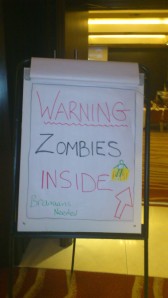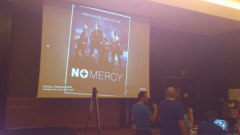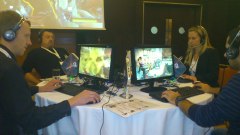Would Your Team Survive the Zombie Apocalypse?
I like Scrum but I love zombies. If there is a zombie related book, comic, film or computer game then I’ve read it, watched it or played it. So what would happen in the unlikely scenario that the two were combined? My favourite session of the 2011 London Scrum Gathering was on hand to answer this unlikely question and another: “Would Your Team Survive the Zombie Apocalypse?”
When I saw the session described in the gathering’s program guide it simply read:
“Would Your Team Survive the Zombie Apocalypse
An exploratory team dynamics session using lan based cooperative gaming”
My first thought was “This session has to involve Left 4 Dead” while my second was “No way am I going to miss this!”.
For those who don’t know Left 4 Dead, it is a computer game for PC and Xbox. It is a cooperative first person shooter where each player assumes the role of one of four survivors caught up in the “Inevitable Zombie Apocalypse”. The objective for the survivors is to progress through a series of game levels known as chapters before ultimately being rescued in a epic finale. At the end of each chapter is a safe room where the survivors can stock up on guns ammunition and medical supplies. Unfortunately for the survivors the areas between safe rooms are populated with zombies known as “infected”. Singly the infected do not pose much of a threat to the survivors but en masse it can be a different story with the potential to be overwhelmed by the so-called “Horde”. In addition the survivors will come across monsters known as “special infected” which are far more deadly than regular infected having special skills like such as the ability to pin survivors down rendering them helpless or cover them in toxic goo. The survivors can fight back with progressively powerful guns, melee weapons such as baseball bats and axes and make use of special items such as medical kits and molotov cocktails.
What does Left 4 Dead have to do with Scrum? For me Left 4 Dead is the ultimate cooperative shooter game. If a survivor goes off on their own they will die. If a survivor is pinned down by a special infected and they are not helped by a team mate they will die. If a survivor is knocked over and not helped up by a team mate they will die. If a team does not share their resources such as medical supplies their team mates will be slowed down and will die. If a team do not work together during the epic set pieces thrown up by the game they will all die. There are other examples but you get the idea. Survivors have to work together or they will die. The game mechanics of Left 4 Dead make communication and effective team work more important than any individual survivor’s skill with a keyboard and mouse or controller.
One of the main advantages of Scrum is the creation of self-organizing, self-led teams. For me Left 4 Dead simulates this ideal with its cooperate-or-die game mechanics. The goal of self-organizing to complete deliverables is replaced with simply surviving and, ultimately, being rescued.
The session was organised by James Scrimshire who described it as a means of illustrating the Five Dysfunctions of a Team. This was a new concept for me and I’ll try and do it justice here. The dysfunctions are layered one on top of the other in a pyramid with each dysfunction being the cause of those above it. For example the bottom dysfunction is “Absence of Trust” which can occur where, for example, people don’t ask for help because they don’t want to feel vulnerable. This can feed directly into the dysfunction “Fear of Conflict” because with no trust a team will not wish to get into conflict with each other. Fear of conflict is a dysfunction because in some cases, conflict, as opposed to artificial consensus, can be good for a team. The layers carry on through “Lack of Commitment”, “Avoidance of Accountability” and “Inattention to Results”.
There were eight networked PCs available grouped at two tables with keyboard and mouse for controls and microphone for communication (although I quickly took mine off preferring to talk directing to the rest of the team). We all had flat screen monitors and the output of one of these was replicated on a large screen. This allowed those attendees not playing to get a flavour for what was going on. The PC cases had been modified to show a very cool Left 4 Dead logo and each player was given a one page illustrated guide to the game’s special infected and items. James and his assistant Sam were on hand to jump-start the players with a quick guide to the game’s controls. James is to be congratulated for the organisation and level of detail he put into this session.
The initial session utilised a special game mode in Left 4 Dead called “Versus” whereby one group of four takes on the role of the survivors while the other group of four plays as the special infected. Each team takes a turn playing survivors or special infected for each game chapter and a score board is maintained. I’m a veteran Left 4 Dead player and so far this is standard stuff. However, there were several twists that made it more interesting and applicable to the session.
Normally in Left 4 Dead you play over the Internet with people who are usually strangers with only voice for communication. This anonymity can lead to people being quite vicious to each other sometimes hurling abuse when things don’t go their way. Here, however, everyone was in the same room. This made it a very safe experience, especially for the majority of attendees who had never played the game before. With this safety in place teams could quickly start to develop some trust for each other and communicate more effectively than they would to do remotely.
The next interesting thing was the range of skills available in the teams. A couple of people such as myself had played the game before, while some had maybe played other similar first person shooter games such as “Modern Warfare”, while for some people it was all completely new. This gave those with experience the opportunity to help their team mates by explaining game mechanics as they went along, guiding them through the unfamiliar levels and, initially, protecting them. For the first few levels my team had two experienced players while the other had none. We tanked them which led to a rebalancing of the teams by James so that one of our experienced players swapped teams. This made things far more even but it is important to note that even before the rebalancing the inexperienced team showed improvement as they learned to work together. By the end of the session the two teams were performing equally well with the previously inexperienced team members coming forward with their own ideas of how to succeed at the game.
The most interesting twist was what happened between levels. Rather than just plough on with the next level we took a break and had a talk within the teams. Part of this was a discussion of where our team was on the five dysfunctions pyramid and whether or not we were climbing it. We also talked about what went well, what didn’t and what we could do to improve for the next round. This was, of course, a mini retrospective and it certainly helped the teams to identify solutions to improve their performance. In fact with the addition of the retrospectives it could be said that each level of play was the equivalent of a sprint in Scrum terms and it certainly worked out that way.
What I really liked was what I saw when I was watching others playing rather than playing myself. In a very short space of time you could see these small teams of strangers playing a computer game and quickly accelerating through the stages of Forming, Storming, Norming and Performing. It was nice to see this in action as with a normal software development team these steps can take months to progress through.
The pictures featured in this post are not from the first session which was held in a small conference room. That was cool enough with a largish projector and modest sound system. What was even better was when the session was expanded into the Open Sessions time on the third day. For this James took over one half of the main conference hall. This had a massive screen (as you can see from some of the pictures) and a very loud sound system. It was awesome switching being seeing Left 4 Dead on the big screen and watching the interactions between the team playing while hearing the loud screams of infected and the roar of machine guns.
A modification for the second session was to have only four PCs and have the team play the straight campaign game, i.e. the special infected are controlled by the game, not other players. This is actually my favourite mode when I play myself and I think it works better for the purposes of the session as the element of competition with another team is removed. James also remarked that it is easier for him to keep an eye on one team rather than two which makes sense. I like that the session’s format is a work in progress. I can see this emerging concept mutate further over time as James presents it. There is certainly scope for expansion and perhaps a Left 4 Dead mod may appear to support it at some point.
What this session was not was simply wasting time playing a computer game. The session proved to be a good tool for demonstrating team dynamics and rapid team evolution while playing a game. I hope the concept is carried on and developed because it has a lot of potential.
Update: James has written his own post about his motivations for creating this session. Check it out here.
Explore posts in the same categories: Agile, ScrumTags: Agile, Left 4 Dead, Scrum, Zombies
You can comment below, or link to this permanent URL from your own site.






October 24, 2011 at 10:25 am
Hi Wayne,
About the book, the 5 dysfunctions of a team, I have published an article that is based on this book and lists the best practices that revolve around building a great team. I hope you’ll have the chance to read it.
August 20, 2012 at 2:15 pm
[…] Read an attendees review here […]